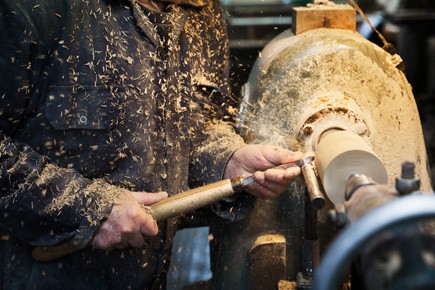First off, let’s talk about the dangers of working with lathe wood turning. One of the biggest risks is the potential for a piece of wood to come loose and fly off the lathe. This can happen for a variety of reasons, such as the wood not being properly secured, or the lathe being operated at too high of a speed. If this happens, the wood can become a dangerous projectile, potentially causing serious injury or damage to property.
Another danger is the potential for the lathe tool to catch the wood and pull it out of your hand. This can happen if you’re not holding the wood firmly enough or if the lathe tool catches on a rough spot in the wood. This can also lead to serious injury, so it’s important to always be aware of where your hands are in relation to the lathe tool.
In addition to these dangers, there are also health risks associated with working with lathe wood turning. One of the biggest risks is exposure to wood dust. This can cause a number of respiratory problems, including allergies, asthma, and even cancer. It’s important to wear a dust mask and use proper ventilation to reduce your exposure to wood dust.
So, now that we’ve talked about the dangers, let’s move on to some safety recommendations. First off, always make sure your lathe is in good working order. Check it regularly for any loose or damaged parts, and make sure it’s properly lubricated. If you notice any issues, address them immediately to prevent any potential accidents.
Next, always wear proper safety gear when working with lathe wood turning. This includes safety glasses or goggles, a dust mask or respirator, and hearing protection. You may also want to wear a face shield to protect against any flying debris.
When setting up your lathe, make sure the wood is properly secured. Use a chuck or a faceplate to hold the wood in place, and make sure it’s centered and balanced. This will help prevent the wood from coming loose and flying off the lathe.
When using the lathe tool, always keep your hands out of the way. Hold the wood firmly with both hands, and keep your fingers away from the lathe tool. Move the tool slowly and smoothly, and always use light pressure. If the tool catches on the wood, don’t try to force it – instead, stop the lathe and adjust the tool or the wood.
Finally, be sure to clean up properly after you’re done working with lathe wood turning. Sweep up any sawdust or wood chips, and dispose of them properly. This will help reduce the risk of fire or other accidents.
So, there you have it – some important safety recommendations for working with lathe wood turning. Remember, the key to staying safe is to be aware of the potential dangers and to take steps to prevent accidents from happening. By following these tips, you can enjoy the art of lathe wood turning while staying safe and healthy. Thanks for tuning in, and until next time, keep creating!
Cheers,

![]()






